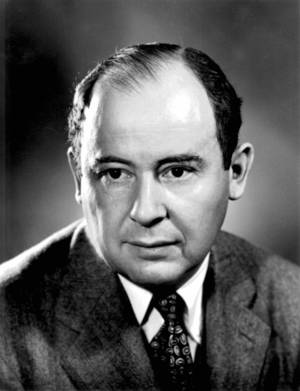John von Neumann (nonfiction): Difference between revisions
| Line 23: | Line 23: | ||
== Nonfiction cross-reference == | == Nonfiction cross-reference == | ||
* [[Benoit Mandelbrot (nonfiction)]] - Student | |||
* [[Cellular automaton (nonfiction)]] | * [[Cellular automaton (nonfiction)]] | ||
* [[Clifford Hugh Dowker (nonfiction)]] - Student | |||
* [[Computer science (nonfiction)]] | * [[Computer science (nonfiction)]] | ||
* [[Donald B. Gillies (nonfiction)]] - Doctoral student | |||
* [[Israel Halperin (nonfiction)]] - Doctoral student | |||
* [[John Backus (nonfiction)]] | * [[John Backus (nonfiction)]] | ||
* [[László Rátz (nonfiction)]] - Academic advisor | |||
* [[Lipót Fejér (nonfiction)]] - Doctoral advisor | |||
* [[Manhattan Project (nonfiction)]] | * [[Manhattan Project (nonfiction)]] | ||
* [[Paul Halmos (nonfiction)]] - Student | |||
* [[Universal Turing machine]] | * [[Universal Turing machine]] | ||
| Line 33: | Line 40: | ||
* [https://en.wikipedia.org/wiki/John_von_Neumann John von Neumann] @ Wikipedia | * [https://en.wikipedia.org/wiki/John_von_Neumann John von Neumann] @ Wikipedia | ||
[[Category:Nonfiction (nonfiction)]] | [[Category:Nonfiction (nonfiction)]] | ||
| Line 40: | Line 46: | ||
[[Category:Mathematicians (nonfiction)]] | [[Category:Mathematicians (nonfiction)]] | ||
[[Category:People (nonfiction)]] | [[Category:People (nonfiction)]] | ||
[[Category:Philosophers (nonfiction)]] | [[Category:Philosophers (nonfiction)]] | ||
[[Category:Physicists (nonfiction)]] | [[Category:Physicists (nonfiction)]] | ||
[[Category:Polymaths (nonfiction)]] | [[Category:Polymaths (nonfiction)]] | ||
Revision as of 20:19, 20 November 2017
John von Neumann (/vɒn ˈnɔɪmən/; Hungarian: Neumann János Lajos, pronounced [ˈnɒjmɒn ˈjaːnoʃ ˈlɒjoʃ]; December 28, 1903 – February 8, 1957) was a Hungarian-American mathematician, physicist, inventor, computer scientist, and polymath.
He made major contributions to a number of fields, including mathematics (foundations of mathematics, functional analysis, ergodic theory, geometry, topology, and numerical analysis), physics (quantum mechanics, hydrodynamics, and quantum statistical mechanics), economics (game theory), computing (Von Neumann architecture, linear programming, self-replicating machines, stochastic computing), and statistics.
He was a pioneer of the application of operator theory to quantum mechanics, in the development of functional analysis, and a key figure in the development of game theory and the concepts of cellular automata, the universal constructor and the digital computer.
He published over 150 papers in his life: about 60 in pure mathematics, 20 in physics, and 60 in applied mathematics, the remainder being on special mathematical subjects or non-mathematical ones. His last work, an unfinished manuscript written while in the hospital, was later published in book form as The Computer and the Brain.
His analysis of the structure of self-replication preceded the discovery of the structure of DNA. In a short list of facts about his life he submitted to the National Academy of Sciences, he stated "The part of my work I consider most essential is that on quantum mechanics, which developed in Göttingen in 1926, and subsequently in Berlin in 1927–1929. Also, my work on various forms of operator theory, Berlin 1930 and Princeton 1935–1939; on the ergodic theorem, Princeton, 1931–1932."
During World War II he worked on the Manhattan Project, developing the mathematical models behind the explosive lenses used in the implosion-type nuclear weapon.
After the war, he served on the General Advisory Committee of the United States Atomic Energy Commission, and later as one of its commissioners. He was a consultant to a number of organizations, including the United States Air Force, the Army's Ballistic Research Laboratory, the Armed Forces Special Weapons Project, and the Lawrence Livermore National Laboratory. Along with theoretical physicist Edward Teller, mathematician Stanislaw Ulam, and others, he worked out key steps in the nuclear physics involved in thermonuclear reactions and the hydrogen bomb.
In the News
Fiction cross-reference
Nonfiction cross-reference
- Benoit Mandelbrot (nonfiction) - Student
- Cellular automaton (nonfiction)
- Clifford Hugh Dowker (nonfiction) - Student
- Computer science (nonfiction)
- Donald B. Gillies (nonfiction) - Doctoral student
- Israel Halperin (nonfiction) - Doctoral student
- John Backus (nonfiction)
- László Rátz (nonfiction) - Academic advisor
- Lipót Fejér (nonfiction) - Doctoral advisor
- Manhattan Project (nonfiction)
- Paul Halmos (nonfiction) - Student
- Universal Turing machine
External links:
- John von Neumann @ Wikipedia

